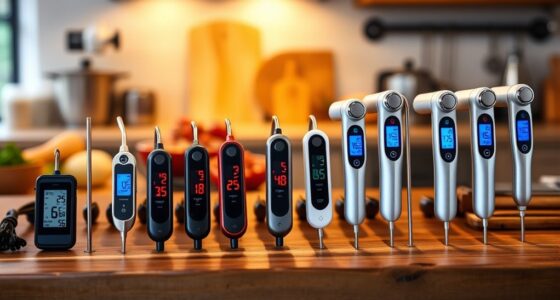If you’re looking for the best thermal imaging cameras for home inspections in 2025, I recommend models with high resolution, durable design, and versatile features like MSX overlays and adjustable temperature ranges. Devices such as the TOPDON TC004, HF96, and FLIR options are popular for detecting leaks, electrical issues, and insulation gaps easily. Choosing the right one depends on your budget and specific needs—stick around to discover detailed insights about each option to make an informed choice.
Key Takeaways
- High-resolution thermal sensors (240×240 to 640×480) enable detailed detection of insulation, leaks, and electrical faults.
- Advanced features like MSX overlay and fusion modes improve image clarity for easier identification of hidden issues.
- Rugged, portable designs with long battery life ensure reliable use during extensive home inspections.
- Connectivity options such as Wi-Fi, Bluetooth, and SD card support seamless data sharing and reporting.
- Cost-effective models balancing affordability and essential features are suitable for both DIY and professional home inspections.
TOPDON TC004 Mini Thermal Imaging Camera

If you’re looking for a reliable and portable thermal imaging camera for home inspection, the TOPDON TC004 Mini stands out with its impressive 128×128 IR resolution, upgraded to 240×240 TISR. This device provides detailed, high-quality thermal images with a wide 40°x30° field of view and a smooth 25Hz refresh rate. It supports five color palettes, making it adaptable for various inspections, and offers real-time temperature readings from -4°F to 842°F. Compact and durable, it fits easily in your pocket, withstands drops, and boasts a long-lasting battery. It’s perfect for detecting heat leaks, electrical issues, and insulation gaps quickly and accurately.
Best For: homeowners, HVAC technicians, and electrical inspectors seeking a portable, reliable thermal imaging camera for quick and accurate diagnostics.
Pros:
- High-resolution thermal imaging with upgraded 240×240 TISR detail for clearer images
- Compact, lightweight, and durable design suitable for on-the-go inspections
- Supports multiple color palettes and real-time temperature readings for versatile use
Cons:
- Smaller screen size may be challenging for users with visual impairments
- Water leak detection may be limited on wet drywall surfaces
- Requires complete charging before initial use to ensure optimal performance
HF96 Thermal Camera with 240×240 IR Resolution and Laser Pointer

The HF96 Thermal Camera stands out for its high-resolution 240×240 IR sensor, making it ideal for professionals and serious DIYers who need detailed thermal images. It features live enhancement from a 96×96 IR resolution, a laser pointer for precise targeting, and fusion mode that merges optical and thermal images for clarity. With intelligent scene detection using deep learning, it automates leak and insulation gap detection. The device offers a wide temperature range, high sensitivity below 50mk, and supports fine adjustments for accurate measurements. Its durable build, 11-hour battery life, and extensive storage make it a reliable tool for home inspections and troubleshooting.
Best For: Professionals and serious DIYers seeking high-resolution thermal imaging with precise targeting and automatic leak detection.
Pros:
- High-resolution 240×240 IR sensor for detailed thermal images
- Laser pointer and fusion mode for accurate targeting and clarity
- Long 11-hour battery life with extensive storage capacity
Cons:
- Proprietary USB-C cable may require additional accessories
- Rare issues with charging after prolonged use reported by some users
- Higher cost compared to basic thermal cameras for casual users
H128 Handheld Thermal Camera with 240×240 Resolution
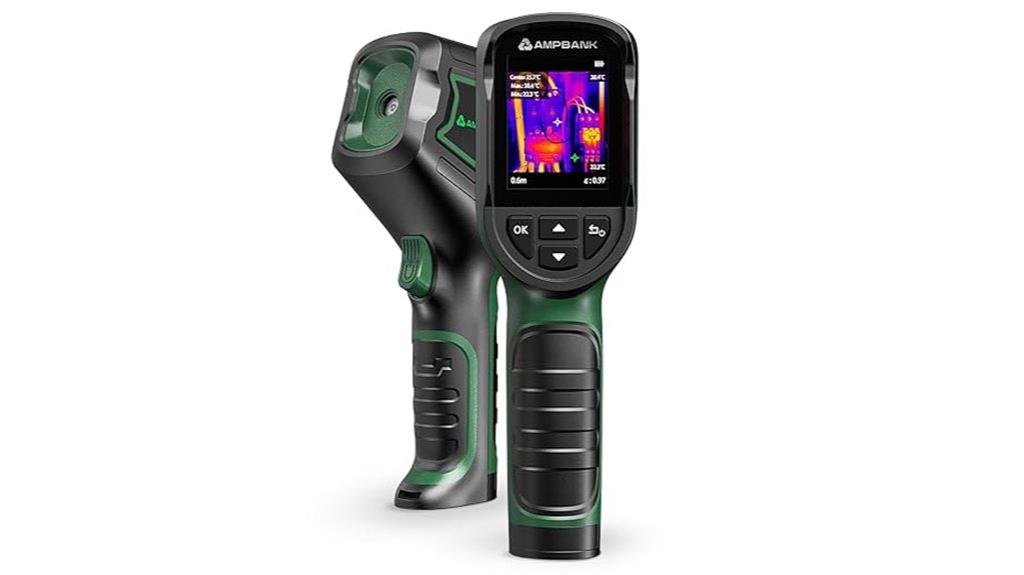
For home inspectors seeking detailed thermal images, the H128 Handheld Thermal Camera with 240×240 resolution stands out thanks to its enhanced clarity and sensitivity. The 240×240 resolution provides sharper images than typical 128×128 models, with a thermal sensitivity of 40mk to detect even minor temperature differences. Its adjustable measurement features, multiple color palettes, and built-in temperature alarm make locating heat anomalies quick and accurate. The device boasts a rugged, ergonomic design with a long-lasting battery, IP65 protection, and a tripod mount for stability. Overall, it’s an excellent tool for energy audits, insulation checks, and troubleshooting, offering reliable performance in a portable package.
Best For: home inspectors and energy auditors seeking detailed, reliable thermal imaging for diagnosing insulation issues, air leaks, and thermal anomalies.
Pros:
- High 240×240 resolution offers clearer, more detailed thermal images than standard models.
- Accurate temperature measurement with ±3% precision and adjustable emissivity for diverse materials.
- Rugged, portable design with long battery life and IP65 rating for durability in various environments.
Cons:
- IR sensor resolution is only 128×128, which may result in slightly blocky images despite the high display resolution.
- No included power adapter; users must rely on USB-C for recharging and data transfer.
- Small display size and limited advanced features may not satisfy professional or specialized users demanding more sophisticated capabilities.
HP96 Thermal Imaging Camera with Touch Screen and IR Resolution

With its 3.5-inch touchscreen and intuitive user interface, the HP96 thermal imaging camera makes home inspections straightforward and efficient. It supports live video and audio recording, with easy adjustments for brightness, color palettes, and temperature ranges. Its dual-camera setup includes a 96×96 IR sensor and a visible light camera, offering five imaging modes and eight color palettes for versatile inspections. Thermal sensitivity below 50mk allows detection of tiny temperature differences, while real-time resolution enhancement ensures clear images. Features like automatic temperature tracking and customizable alerts help identify issues quickly, making the HP96 a powerful tool for pinpointing leaks, insulation gaps, and overheating problems.
Best For: home inspectors, maintenance professionals, and technicians seeking precise thermal imaging for detecting leaks, insulation issues, and overheating in various environments.
Pros:
- High thermal sensitivity below 50mk for detecting tiny temperature differences
- Real-time super resolution technology enhances image clarity from 96×96 to 240×240 pixels
- Durable design with IP54 rating and drop resistance, suitable for tough field conditions
Cons:
- Slightly limited thermal sensor resolution compared to higher-end models (96×96 IR sensor)
- Battery life of up to 4 hours may require additional power management during extended inspections
- Learning curve for utilizing all imaging modes and intelligent scene recognition features
FLIR ONE Gen 3 Thermal Imaging Camera for iOS Smartphones

If you’re an iPhone user looking to enhance your home inspections, the FLIR ONE Gen 3 Thermal Imaging Camera offers a seamless and powerful solution. It plugs directly into your phone’s charging port, with compatibility for iPhones featuring USB-C, like the iPhone 15 and newer. It delivers high-resolution IR images at 1440×1080 and a thermal resolution of 80×60. The built-in inspection guides help identify air leaks, moisture, and faults accurately. With a temperature range of 5°C to 120°C and durability rated to withstand drops, it’s perfect for home, HVAC, automotive, and industrial inspections.
Best For: iPhone users seeking an easy-to-use, high-resolution thermal imaging tool for home inspections, HVAC, automotive, or industrial troubleshooting.
Pros:
- High-resolution images with 1440×1080 visual resolution and 80×60 thermal resolution for detailed thermal analysis
- Built-in inspection guides to assist in accurate detection of air leaks, moisture, and faults
- Durable design rated to withstand drops from 1.5 meters, suitable for jobsite use
Cons:
- Only compatible with iPhones featuring USB-C ports, such as iPhone 15 and newer, limiting compatibility with older models
- Temperature measurement accuracy within ±3°C or ±5%, which may not suffice for very precise industrial applications
- Requires direct connection to the phone’s charging port, which may interfere with other accessories or charging needs
FLIR C5 Compact Thermal Imaging Camera

The FLIR C5 Compact Thermal Imaging Camera stands out as an ideal choice for home inspectors seeking a portable, easy-to-use device that delivers reliable thermal insights. Its high-resolution infrared sensor captures clear images with 160×120 pixels, and MSX technology overlays visual details for better interpretation. With a temperature range from -20°C to 400°C, it’s versatile for detecting electrical faults, air leaks, and plumbing issues. Its built-in LED flashlight and 5-megapixel visual camera enhance usability in various environments. Weighing just 6.7 ounces, it’s lightweight and easy to carry, making quick inspections simple and efficient. Plus, seamless cloud sharing streamlines reporting and documentation.
Best For: Home inspectors and maintenance professionals seeking a portable, easy-to-use thermal camera for quick detection of electrical, building, and HVAC issues.
Pros:
- Compact and lightweight design for easy handling and portability
- High-resolution infrared sensor with MSX technology for clearer images and better interpretation
- Seamless cloud sharing and reporting features streamline documentation and client communication
Cons:
- Lower frame rate (9Hz) may limit real-time thermal video quality
- Smaller image resolution compared to higher-end models can affect detailed analysis
- Occasional connectivity and calibration issues reported by some users
TOPDON TC004 Thermal Imaging Camera
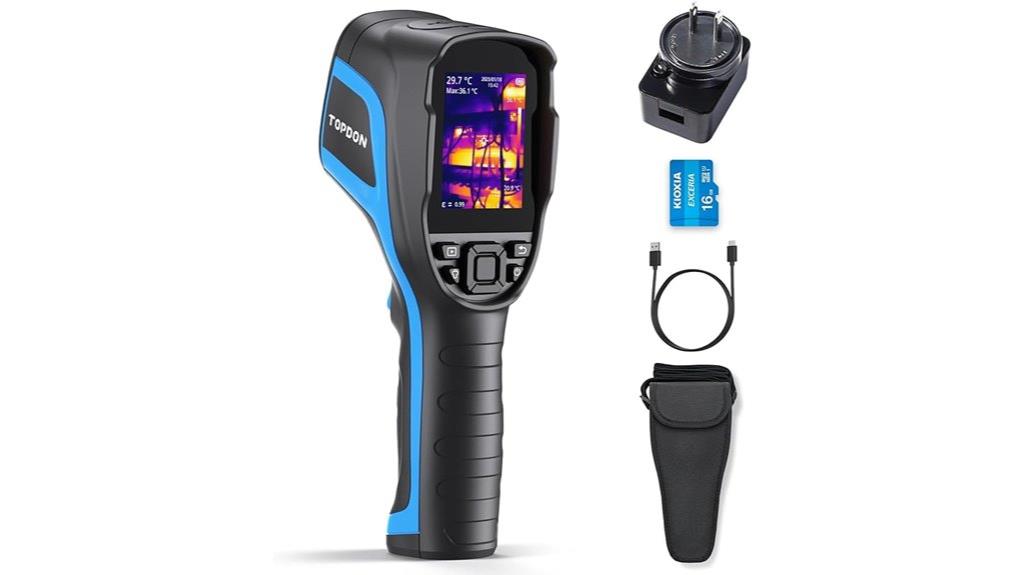
For homeowners and home inspectors seeking accurate thermal detection, the TOPDON TC004 Thermal Imaging Camera stands out thanks to its high-resolution 256×192 IR sensor and fast 25Hz frame rate. It offers precise temperature measurements with a sensitivity below 40 millikelvin and a range from -4°F to 662°F. Multiple color palettes improve visualization, making it easier to identify issues. The camera connects to Windows PCs via USB for real-time analysis, supports data storage with up to 32GB SD cards, and allows offline review. With long battery life, built-in alarms, and a durable design, the TC004 is a reliable tool for extensive home inspections.
Best For: homeowners and home inspectors seeking precise thermal detection and reliable performance for extensive property assessments.
Pros:
- High-resolution 256×192 IR sensor provides clear, detailed thermal images
- Long-lasting 12-hour battery life supports extensive inspection tasks
- Supports real-time analysis and data storage with USB connection and SD card expansion
Cons:
- Not compatible with Mac systems for direct software connectivity
- Requires a Windows PC for full analysis and report generation
- May be heavier or bulkier compared to handheld models with fewer features
Handheld Thermal Camera with 512×384 Resolution

A handheld thermal camera with a 512×384 resolution stands out as an excellent choice for home inspectors who need detailed, professional-grade thermal images on the job. Its upgraded 512×384 X³ IR resolution offers sharper, more precise thermal details compared to lower-resolution models. The camera combines thermal and visual analysis with a 2MP visible light camera and a clear 3.5-inch IPS screen. It supports a wide temperature range, professional accuracy, and multiple measurement points. Wireless connectivity, fast data transfer, and long battery life make it highly versatile for various inspection scenarios. Its robust build guarantees durability, making it reliable for demanding inspection environments.
Best For: professional inspectors and technicians requiring detailed thermal imaging for electrical, HVAC, mechanical, or building diagnostics in demanding environments.
Pros:
- High-resolution 512×384 thermal imaging for sharp, detailed visuals.
- Wide temperature measurement range with professional accuracy and adjustable emissivity.
- Long battery life of over 10 hours and durable IP54-rated design for rugged field use.
Cons:
- Slightly heavier and bulkier compared to basic models, which may affect portability.
- Higher price point due to advanced features, potentially limiting accessibility for casual users.
- Requires familiarity with thermal imaging technology to maximize effectiveness and data interpretation.
GOYOJO Thermal Imaging Camera with Dual-Light Fusion
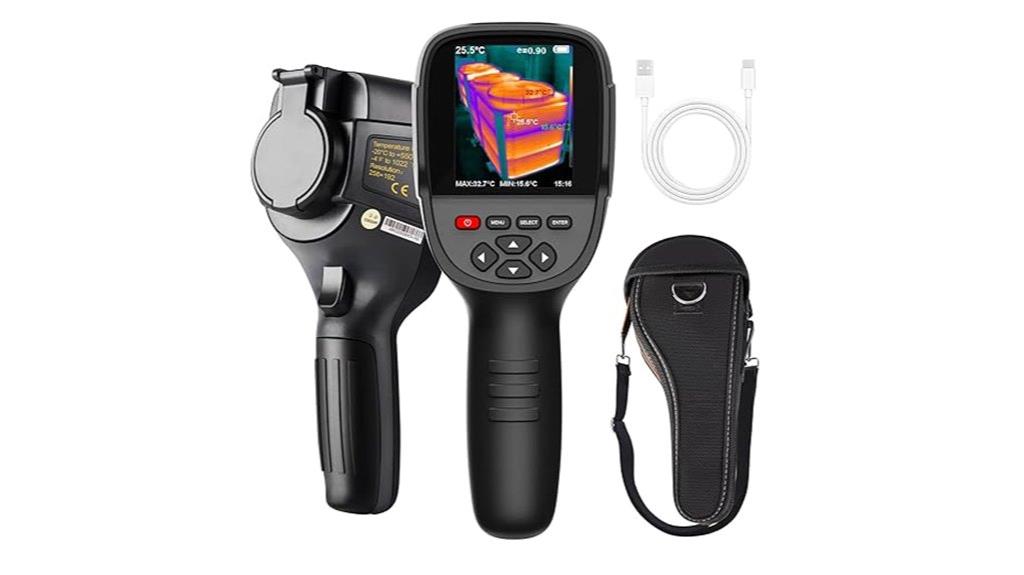
If you’re looking for a thermal imaging camera that combines high-resolution visuals with enhanced visibility, the GOYOJO GW256 with Dual-Light Fusion stands out as an excellent choice. It features a 256×192 IR resolution, delivering clear, detailed thermal images. Its dual-light fusion overlays thermal data onto regular visuals, making it easier to spot issues like leaks, insulation gaps, or electrical faults. The camera’s real-time hot and cold spot tracking helps pinpoint problems quickly across various applications. Its durable design, simple controls, and compatibility with user-friendly software make it a practical tool for both professionals and DIYers aiming to detect hidden issues efficiently.
Best For: DIY enthusiasts, home inspectors, and professionals seeking a reliable thermal imaging camera for detecting insulation issues, leaks, electrical faults, and mechanical problems with high-resolution visuals and enhanced visibility.
Pros:
- High-resolution 256×192 IR imaging for clear, detailed thermal images
- Dual-light fusion overlays thermal data onto regular visuals for easier issue identification
- Durable construction with ergonomic design suitable for various environments
Cons:
- Preloaded software may contain malware; users should download software from trusted sources
- Lacks automatic dual-image saving and firmware update support
- Requires manual battery removal for charging, as it does not include a built-in wall charger
YXI96 Thermal Camera with Infrared Imaging
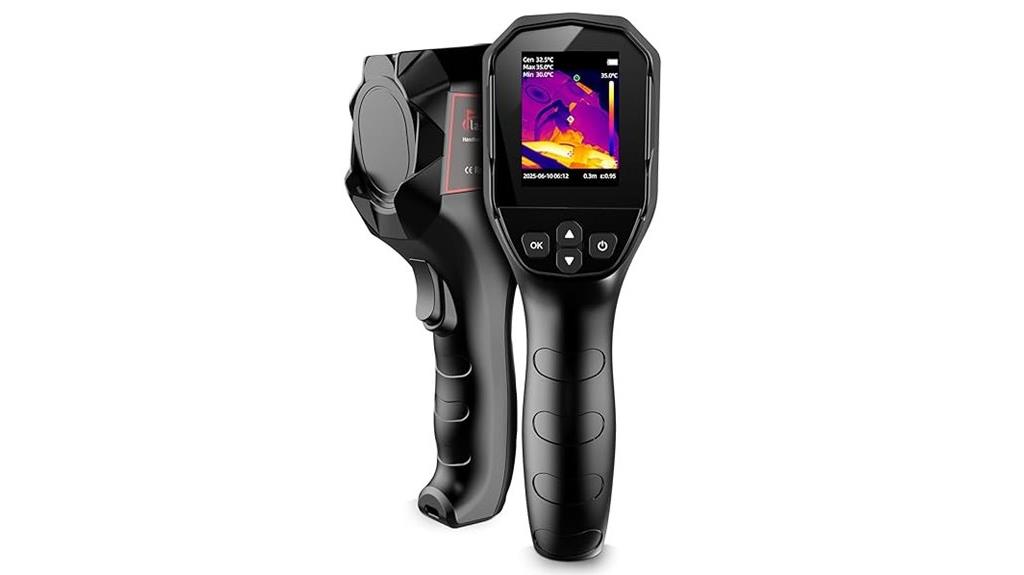
The YXI96 Thermal Camera with Infrared Imaging stands out thanks to its high-resolution 240×240 super-resolution imaging technology, which provides clearer, more detailed thermal images. Its 25Hz refresh rate ensures smooth, real-time inspections, while the 50° field of view covers broad areas quickly. With five color palettes, it offers versatile visualization tailored to different tasks. The camera measures temperatures from -4°F to 1022°F with ±2% accuracy and includes a temperature alarm for detecting abnormal heat sources. Compact, durable, and IP54-rated, it’s ideal for home inspections, helping identify insulation gaps, leaks, and electrical issues efficiently.
Best For: DIY homeowners, professional inspectors, and technicians seeking detailed thermal imaging for detecting heat anomalies, leaks, and electrical issues efficiently.
Pros:
- High-resolution 240×240 super-resolution imaging provides clearer, more detailed thermal images.
- Wide 50° field of view and 25Hz refresh rate enable broad and smooth real-time inspections.
- Versatile visualization with five color palettes and adjustable temperature/emissivity settings enhances usability across various tasks.
Cons:
- The temperature measurement range (-4°F to 1022°F) may not cover extremely high-temperature industrial applications.
- Slightly higher cost compared to basic thermal cameras may be a consideration for budget-conscious users.
- Requires some familiarity with thermal imaging to interpret images accurately for complex issues.
FLIR ONE Pro Thermal Imaging Camera for iOS Smartphones
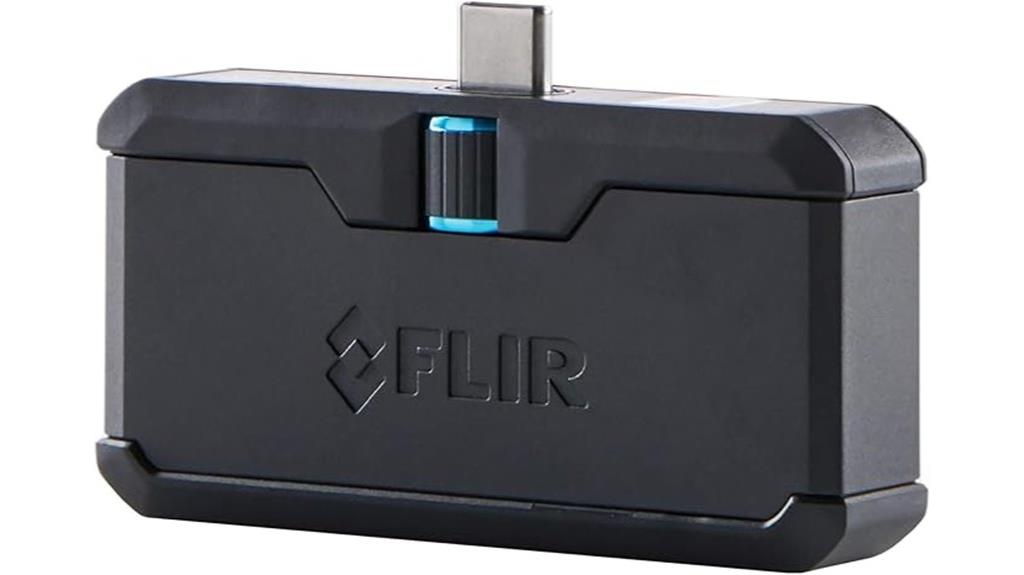
Designed specifically for iPhone 15 and newer models with USB-C ports, the FLIR ONE Pro Thermal Imaging Camera offers high-resolution thermal imaging combined with real-time detail enhancement, making it ideal for homeowners and professionals seeking accurate, on-the-go inspections. It features a super resolution of 320×240 pixels via Vivid IR technology, upscaled from 160×120, with MSX detail overlay. Compact and durable, it measures about 2.6 inches and weighs just over an ounce. Supporting thermal and visible light imaging simultaneously, it helps identify leaks, electrical faults, and insulation issues efficiently. Its portability and robust design make it a versatile tool for quick, reliable home inspections.
Best For: homeowners, electricians, and HVAC professionals seeking portable, high-resolution thermal imaging for quick and accurate inspections on iPhone 15 and newer models with USB-C ports.
Pros:
- High-resolution 320×240 thermal images with MSX detail overlay for clearer diagnostics
- Durable and compact design, rated to withstand drops from 1.5 meters for on-site use
- Supports simultaneous thermal and visible light imaging, allowing overlay for better analysis
Cons:
- Limited manual controls at close range (under 20-30 cm), affecting detailed inspections
- Battery life of approximately one hour may require frequent replacements or charging
- Temperature measurement accuracy of ±3°C or ±5%, which may not suffice for precise scientific applications
Klein Tools TI250 Rechargeable Thermal Imaging Camera

For home inspectors and DIY homeowners alike, the Klein Tools TI250 Rechargeable Thermal Imaging Camera stands out thanks to its high-resolution imaging and adjustable emissivity, which guarantee accurate temperature readings across various surfaces. With over 10,000 pixels, it precisely detects hot and cold spots, making troubleshooting easier. Its user-friendly features include temperature alarms, crosshairs for pinpointing issues, and versatile color palettes for clear visuals. Powered by a rechargeable lithium-ion battery, it supports continuous use and is compact enough for easy handling. The device also allows image storage via microSD, making it ideal for energy audits, insulation checks, and identifying hidden home issues efficiently.
Best For: home inspectors, DIY homeowners, and energy auditors seeking an affordable, accurate thermal imaging tool for troubleshooting and home efficiency improvements.
Pros:
- High-resolution imaging with over 10,000 pixels for precise thermal detection
- Adjustable emissivity for accurate surface temperature readings on various materials
- Compact, user-friendly design with rechargeable battery and image storage capabilities
Cons:
- Slow refresh rate may affect real-time thermal monitoring
- MicroSD card (sold separately) required for image storage
- Slightly limited temperature range compared to higher-end models
FLIR Edge Wireless Bluetooth Thermal Imaging Camera for Smartphones

If you’re looking for a portable and easy-to-use thermal imaging solution to enhance your home inspections, the FLIR Edge Wireless Bluetooth Thermal Imaging Camera is an excellent choice. It’s compatible with all iOS and Android devices, offering high-resolution IR images at 640×480 and 80×60 thermal resolution. Its compact, impact-resistant design makes it ideal for on-the-go inspections, whether checking for insulation gaps, electrical issues, or leaks. The camera connects wirelessly via Bluetooth, and with the FLIR One app, you can capture, analyze, and share thermal images easily. While some users report app stability issues, overall, it provides reliable, detailed thermal data for a variety of inspection needs.
Best For: homeowners, inspectors, and industrial professionals seeking a portable, easy-to-use thermal imaging camera for quick, detailed inspections across various settings.
Pros:
- High-resolution thermal imaging at 640×480 IR and 80×60 thermal resolution
- Compact, impact-resistant design suitable for on-the-go use
- Wireless Bluetooth connectivity with user-friendly app features for capturing and sharing images
Cons:
- Some users experience app stability and connectivity issues, especially on certain Android devices
- Limited frame rate of 9Hz or less may restrict real-time dynamic analysis
- Occasional lack of software updates and support can impact long-term usability
MILESEEY TR10 Thermal Imaging Camera

The MILESEEY TR10 Thermal Imaging Camera stands out with its high-resolution 240 x 240 thermal sensor and a smooth 25 Hz refresh rate, making it ideal for home inspectors who need clear, detailed images. Its multiple display modes, including color schemes like blue, help accommodate different vision needs. The large LCD screen displays temperature readings vividly, simplifying interpretation. With high sensitivity (NETD <50mk), it detects subtle temperature differences and reveals hidden heat sources through drywall. Its ability to differentiate between warm and cold areas in real-time ensures precise inspections. Durable and long-lasting, the TR10 supports extended fieldwork with 8 hours of battery life and ample internal storage.
Best For: home inspectors, electrical engineers, HVAC technicians, and maintenance professionals seeking reliable, high-resolution thermal imaging for detailed diagnostics.
Pros:
- High-resolution 240 x 240 thermal sensor provides clear, detailed images
- 25 Hz refresh rate ensures smooth, real-time viewing experiences
- Multiple display modes and adjustable settings enhance usability and accuracy
Cons:
- Some users report calibration issues affecting temperature accuracy
- Customer service and support have received mixed reviews
- The device’s advanced features may require a learning curve for new users
Factors to Consider When Choosing Thermal Imaging Cameras for Home Inspection
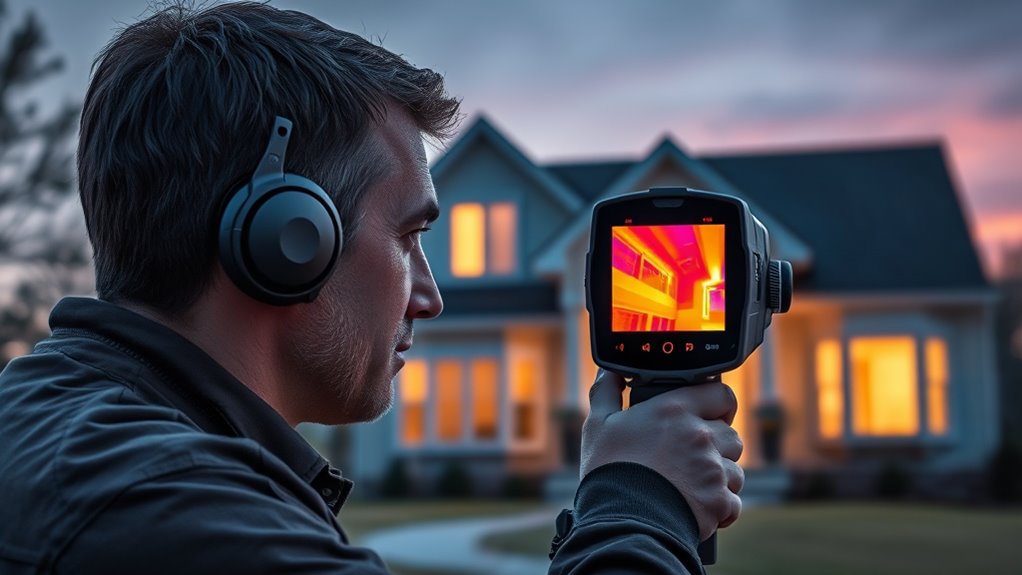
When selecting a thermal imaging camera for home inspections, I consider several key factors to guarantee I get the right tool for the job. Things like resolution quality, temperature range, durability, ease of use, and data storage all impact performance. Let’s explore these points to help you make an informed choice.
Resolution Quality Levels
Choosing the right thermal imaging camera largely depends on its resolution, which directly impacts image clarity and detail. Higher resolution sensors, like 240×240 or 320×240, produce sharper images essential for spotting small leaks or insulation gaps. Cameras with lower resolutions, below 128×128, often generate blocky images that make it difficult to see subtle temperature differences or fine details. Resolution isn’t the only factor; thermal sensitivity, measured in millikelvins, also matters—lower values (under 50mK) allow detection of even tiny temperature variations. Better resolution and display quality together enhance image clarity, making diagnostics more accurate, especially in complex or cluttered environments. Ultimately, higher-resolution cameras provide more precise insights, improving your ability to identify hidden issues during home inspections.
Temperature Range Options
Selecting a thermal imaging camera with the right temperature range is essential for effective home inspections because it determines the scope of issues you can detect. Cameras typically range from -4°F (-20°C) to over 1022°F (550°C), covering everything from cold leaks to hot electrical hotspots. A broader range allows you to identify a variety of problems, like insulation gaps or electrical faults. Accuracy within this range is crucial—look for a camera with a specified margin of error, such as ±2%. Adjustable temperature ranges or emissivity settings can help tailor measurements to different surfaces and materials, enhancing precision. Knowing the minimum and maximum temperature limits prevents misinterpretation, especially in environments with extreme temperatures, ensuring you get reliable, actionable data during inspections.
Device Durability Standards
Ensuring your thermal imaging camera can withstand the rigors of home inspections is just as important as its imaging capabilities. Look for devices with an IP54 rating or higher; this guarantees resistance to dust and water, which are common in inspection environments. Drop resistance is also vital—choose cameras that can handle falls from at least 2 meters to prevent damage during accidental drops. Sturdy materials like reinforced plastic or metal housings improve durability and extend the device’s lifespan. Certifications or compliance with industry standards for environmental resistance can give you added confidence in its reliability. Features such as reinforced lens covers and sealed buttons help protect against dust, humidity, and wet conditions, ensuring your camera remains functional in challenging environments.
Ease of Operation
When evaluating thermal imaging cameras for home inspections, ease of operation is crucial to getting accurate results quickly. A user-friendly interface with intuitive controls and clear menus ensures I can navigate the device efficiently. Cameras with automatic calibration and preset modes simplify the process, reducing manual adjustments and making them accessible even for beginners. A large, high-resolution screen enhances thermal image visibility, allowing me to interpret data without extensive training. Features like one-touch photo and video recording, combined with straightforward navigation buttons, help me capture data efficiently during inspections. Additionally, clear instructions, digital manuals, or guided workflows support effective use, especially in complex or low-light situations. These features collectively make the inspection process smoother and more precise.
Connectivity and Storage
To make the most of a thermal imaging camera for home inspections, I need reliable connectivity and ample storage options. I look for cameras with enough internal memory or support for external SD cards to save high-resolution images and videos for detailed analysis. Wireless data transfer features like Wi-Fi or Bluetooth are essential, as they make sharing and remote viewing quick and effortless. Compatibility with software platforms or apps helps me organize data, generate reports, and integrate with cloud storage. I also consider battery life in relation to storage capacity, ensuring the device can handle extended inspections without running out of power or space. Additionally, real-time streaming to computers or mobile devices allows for immediate analysis and decision-making during inspections, saving time and improving accuracy.
Power and Battery Life
Long battery life is essential for home inspections, as it allows me to work uninterrupted for extended periods. I look for thermal cameras with batteries that offer at least 8 to 12 hours of continuous use, so I can cover large areas without frequent recharges. Quick recharge times or USB-C charging are also valuable, minimizing downtime between inspections. Some models automatically shut off or enter sleep mode to conserve power, which helps during long sessions. Battery capacity and performance can vary depending on environmental conditions, so I always check the specifications for ideal operating ranges. Having reliable, long-lasting power ensures I stay productive, reduce interruptions, and complete inspections efficiently without worrying about running out of juice mid-task.
Price and Budget Fit
Choosing the right thermal imaging camera ultimately depends on your budget and the features you need. These cameras vary widely in price—from budget models around $200 to professional-grade devices over $2,000. Setting a clear budget helps you focus on essential features like resolution, temperature range, and image storage, making sure you get value for your money. Cheaper models often have lower IR resolution and less accurate temperature readings, which could limit inspection effectiveness. Investing a bit more in a higher-priced camera can provide better detail, reliability, and long-term value. Comparing costs against your specific inspection needs ensures you choose a device that fits your budget without sacrificing performance. This way, you get a balance between affordability and functionality for effective home inspections.
Frequently Asked Questions
How Does Thermal Resolution Affect Detection Accuracy?
Thermal resolution directly impacts detection accuracy because higher resolution lets me see finer details in temperature differences. When a camera has better thermal resolution, I can identify small or subtle issues like tiny leaks or insulation gaps more precisely. Lower resolution might miss these clues or produce blurry images, making it harder to diagnose problems confidently. So, for accurate inspections, I always prefer cameras with higher thermal resolution.
Are There Specific Brands Recommended for DIY Home Inspections?
I recommend brands like FLIR, Seek Thermal, and Hti-Xintai for DIY home inspections. These brands offer reliable thermal cameras that are user-friendly and provide good image quality, making it easier for you to spot hidden issues. I’ve found that these options balance affordability with performance, so you can confidently identify leaks, electrical problems, or insulation gaps without needing professional-grade equipment.
What Is the Typical Battery Life for These Thermal Cameras?
Most thermal imaging cameras I’ve used last around 4 to 8 hours on a single charge, depending on the model and usage. Some high-end units have quick-swappable batteries, so you can keep working without interruption. If you’re planning long inspections, I recommend choosing a camera with extended battery life or carrying spare batteries. Always check the specs before buying to make sure it meets your needs.
Can Thermal Cameras Detect Issues Through Walls or Only on Surfaces?
Thermal cameras can’t see through walls; they detect temperature differences on surfaces. When I use one, I look for anomalies like cold spots or hot areas on walls, floors, or ceilings that suggest hidden issues like leaks or insulation gaps. The key is understanding that the camera shows surface temperature variations, helping me locate problems behind walls without invasive inspection, but it doesn’t penetrate through solid barriers.
How Important Is Temperature Range for Home Inspection Purposes?
The temperature range is essential for home inspections because it determines the camera’s ability to detect various issues like leaks or insulation gaps. I look for cameras with a broad range, ensuring I catch subtle temperature differences. A wider range helps me identify hidden problems more accurately. So, when choosing a thermal camera, I prioritize its temperature capabilities to get the best results for my inspections.
Conclusion
If you’re serious about home inspections, investing in a quality thermal imaging camera is a game-changer. With options like the TOPDON TC004 or FLIR ONE Gen 3, you can easily spot hidden issues before they become costly repairs. Just consider your needs and budget, and you’ll find the perfect fit. A good thermal camera gives you peace of mind and helps keep your home safe and efficient.





